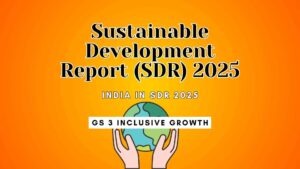Indian FDI Mystery- Important UPSC Notes
Indian FDI Mystery
📖 What is FDI (Foreign Direct Investment)?
FDI means investment by a foreign company or person into Indian businesses.
The foreign investor usually:
Buys ownership (equity) shares in an Indian company.
Sets up a new business unit or a joint venture.
🔸 FDI is different from Foreign Portfolio Investment (FPI).
FDI is long-term, where the investor takes interest in running the business.
FPI is short-term, just buying and selling shares in the stock market.
🌟 Why is FDI Important for India?
FDI helps India in many ways:
💰 Capital: Brings money for industries, infrastructure, startups.
🧠 Technology Transfer: Brings advanced technology and management skills.
👩💼 Jobs: Generates employment for skilled and unskilled workers.
💵 Improves Balance of Payments (BoP): Helps in managing imports and exports better.
🌐 Global Reach: Connects Indian companies to the global market.
🔹 What is Disinvestment?
Disinvestment means taking money out of an existing investment.
In the context of FDI, disinvestment happens when foreign investors withdraw their money from companies they had earlier invested in.
👀 Example:
Imagine a foreign company buys 20% shares in an Indian mobile company (like Jio or Airtel). That’s FDI.
But after a few years, if the company sells off its shares and takes the money back to its home country, that’s disinvestment.
When disinvestment happens:
It reduces India’s foreign investment stock.
It may cause net FDI (inflow minus outflow) to go down.
📈 What’s the FDI Paradox?
The RBI (Reserve Bank of India) released a report in 2024–25 showing something unusual:
India received a 13.7% increase in total FDI (Gross FDI Inflow).
But the net FDI (after removing disinvestment) was just $0.4 billion, a huge fall from $44 billion in 2020–21.
💡 Why the paradox?
Because while more foreign money is coming in, even more is going out as investors are pulling out their earlier investments (disinvestment).
🔍 What Did the RBI Report Say?
Here are some key takeaways from the RBI’s 2024–25 report:
📊 Gross FDI inflow increased by 13.7%.
🐢 But in the last 4 years, average growth in FDI was just 0.3% per year.
🔻 Net FDI fell drastically to $0.4 billion.
🔁 Disinvestments (withdrawals by foreign investors) have been rising fast.
🌍 Most FDI came from Singapore (15%) and Mauritius (~10%) – which are often used for tax-saving and round-tripping (explained below).
🏭 FDI in manufacturing fell to only 12% of the total.
🇮🇳 At the same time, Indian companies are investing more abroad – outward FDI rose to $29.2 billion.
🛑 Problems with FDI in India (As Per Report)
High Disinvestment Rate:
Earlier, most FDI stayed in India.
Now, 63.5% of the foreign investment goes back through disinvestment.
Short-Term Focus:
Many investors (especially private equity firms) come only to make quick profits, not to help industries grow.
Wrong Sectors Attracting FDI:
Less FDI in core sectors like manufacturing and services.
More FDI in apps, digital platforms, and finance — which may not create long-term jobs.
Decline in Quality Investors:
Countries like USA, UK, Germany (known for high-tech investment) are investing less.
Mismatch in Data:
UNCTAD data (a UN body) shows FDI is much lower than what RBI reports — may mean RBI’s method overstates FDI.
🧠 Important Terms (Explained Simply)
Gross FDI: Total money coming into India from foreign investors.
Net FDI: Gross FDI minus disinvestment.
Round-Tripping: When Indian money goes out (e.g., to Mauritius) and comes back as FDI to save tax.
Repatriation: Foreign companies taking back their profits or selling their shares and returning the money home.
Balance of Payments (BoP): A country’s financial sheet of money inflow and outflow through trade and investment.
✅ What Can Be Done?
Stable FDI Policy:
Foreign investors should feel safe and confident to invest for the long term.
Encourage Good FDI:
Push for investments in areas like green energy, manufacturing, and research & development (R&D).
Reform Labour and Land Laws:
Make it easier to start and run a business in India.
Fix Tax Treaties:
Avoid misuse of tax loopholes through countries like Mauritius.
Track Real FDI Impact:
Monitor if FDI is creating jobs, producing goods, or just making profits for the investor.
🧾 Summary in Simple Words
Even though more foreign money is coming into India, a lot of it is going back out.
This makes India’s FDI story look good from the outside, but in reality, it’s not helping as much in building industries or creating jobs.
India needs to focus on quality investment that stays and grows the economy.
🎯 Prelims Quick Facts
Net FDI in 2024–25 = $0.4 billion
Highest FDI from = Singapore (15%)
Share of FDI in Manufacturing = 12%
Outward Indian FDI = $29.2 billion
Disinvestment Share = 63.5% of total FDI
Mains-Based Questions on Indian FDI Mystery
Q1.
Despite increasing gross FDI inflows, India’s net FDI has declined drastically in recent years. Examine the reasons for this paradox and suggest measures to address it.
Answer Framework:
Introduction
Define FDI and its importance for India’s economic development.
Mention the recent RBI report highlighting the FDI paradox: Gross FDI ↑, but Net FDI ↓ to $0.4 billion in 2024–25.
Body
🟢 Reasons for Declining Net FDI:
Rising disinvestment and repatriation (63.5% of gross FDI).
Dominance of short-term financial flows over long-term productive investments.
Declining FDI in manufacturing and services.
Geographical concentration in financial hubs like Singapore, Mauritius.
Decreasing investments from tech-leading countries (US, Germany, UK).
Data inconsistencies (UNCTAD vs. RBI).
🔧 Measures to Address the Paradox:
Ensure policy and regulatory stability for long-term investor confidence.
Shift focus to quality FDI in manufacturing, green tech, and R&D.
Ease of Doing Business: reforms in land, labour, compliance.
Rationalize tax treaties to prevent round-tripping.
Build robust FDI monitoring mechanisms to assess real contribution.
Conclusion
India must shift from just attracting FDI to attracting the right kind of FDI for sustainable growth and sectoral development.
Q2.
Foreign Direct Investment in India is increasingly becoming financial in nature, rather than production-oriented. Critically analyse.
Answer Framework:
Introduction
Define FDI and differentiate between productive vs. financial flows.
Mention recent trends as per RBI: FDI coming from tax havens, disinvestments rising.
Body
🔎 Evidence of Financial Nature of FDI:
Dominance of flows from Singapore and Mauritius (round-tripping).
Rise of private equity and venture capital funds seeking short-term profits.
Fall in manufacturing share of FDI to 12%.
Low contribution to employment and value creation.
🛠 Implications:
Weak impact on job creation, industrial growth, innovation.
Limited technology transfer.
Increased external vulnerability due to quick disinvestment.
✅ Way Forward:
Attract long-term investors via stable, transparent policy.
Prioritize FDI in productive sectors via targeted incentives.
Tax treaty reforms to discourage financial-only investments.
Improve domestic business climate, especially for MSMEs and manufacturing.
Conclusion
FDI must not just bring capital but must contribute to sustainable and inclusive development.
Q3.
What are the challenges India faces in converting FDI inflows into long-term economic gains? How can the government ensure quality and stability in FDI?
Answer Framework:
Introduction
Briefly explain FDI’s role in economic development.
Mention paradox of high inflows but low net benefits.
Body
🚫 Challenges:
High repatriation/disinvestment.
FDI focused on non-core sectors (apps, fintech).
Lack of coordination between Centre and States.
Regulatory uncertainty and compliance burden.
Skill mismatch and low absorption in domestic labour market.
🛠 Steps to Ensure Quality FDI:
Encourage FDI in labour-intensive and tech-based sectors.
Align policies with Make in India, PLI Schemes.
Improve ease of doing business, reduce red tape.
Invest in infrastructure and skilling to make India investment-ready.
Implement a sectoral monitoring framework.
Conclusion
FDI should be aligned with national development goals.
Emphasis must be on productive, responsible, and innovation-driven capital.
Prelims Questions based on Indian FDI Mystery
-
Stampede Management in India – Important UPSC Notes
A stampede occurred at Chinnaswamy Stadium, Bengaluru, during RCB’s IPL... -
EnviStats India 2025 – Important UPSC Notes
The 8th edition of EnviStats India 2025 was released by... -
Quantum Computing – Important UPSC Notes
Tech giants like Google, IBM, and China’s Jiuzhang have developed... -
Indian Energy Security – Important UPSC Notes
In 2025, India became the 4th largest economy in the... -
Indian Food and Fertiliser Subsidies – Important UPSC Notes
With poverty down to 5.3%, distributing food subsidies to 800... -
India in SDR 2025 – Important UPSC Notes
India in SDR 2025 has ranked 99th, entering the Top... -
Indian FDI Mystery- Important UPSC Notes
India received a 13.7% increase in total FDI (Gross FDI...








